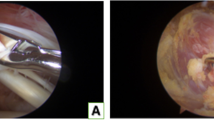Abstract
Objectives
Although the teres minor has received little attention in the literature compared to the other musculotendinous units of the rotator cuff, it is an important component of shoulder function. Our purpose was to study the appearance of the teres minor muscle on CT and MRI images in various patterns of rotator cuff tears.
Materials and methods
We analyzed the appearance of the teres minor according to the Walch classification (normal, hypertrophic, atrophic, or absent) in 1,332 CT and in 240 MRI images of rotator cuff tears and we correlated it with the type of rotator cuff tears, time period between initial onset of symptoms and diagnostic imaging, age of the patient at the time of imaging, and degree of fatty infiltration of other rotator cuff muscles.
Results
The teres minor was classified as normal in 90.8% of cases, hypertrophic in 5.8%, atrophic in 3.2%, and absent in 0.2%. Significant variability existed in the appearance of the teres minor muscle among different patterns of rotator cuff tears in the CT (P < 0.0001) and MRI groups (P < 0.0001). The teres minor appeared most frequently hypertrophic in anterior tears and atrophic in posterior-superior tears.
Conclusions
The teres minor was normal in most rotator cuff tears. A morphologic classification system allowed the appearance of the teres minor to be defined in isolated and multiple rotator cuff tears in CT and MRI images.




Similar content being viewed by others
References
Ovesen J, Söjbjerg JO. Posterior shoulder dislocation. Muscle and capsular lesions in cadaver experiments. Acta Orthop Scand. 1986;57(6):535–6.
Hottya GA, Tirman PF, Bost FW, Montgomery WH, Wolf EM, Genant HK. Tear of the posterior shoulder stabilizers after posterior dislocation: MR imaging and MR arthrographic findings with arthroscopic correlation. AJR Am J Roentgenol. 1998;171(3):763–8.
Sofka CM, Lin J, Feinberg J, Potter H. Teres minor denervation on routine magnetic resonance imaging of the shoulder. Skeletal Radiol. 2004;33:514–8.
Linker CS, Helms CA, Fritz RC. Quadrilateral space syndrome: findings at MR imaging. Radiology. 1993;188:675–6.
Walch G, Nové-Josserand L, Liotard JP, Noel E, Tavernier TH, Barthélémy R. Le petit rond (teres minor): l'oublié de la coiffe. In: Blum A, Tavernier T, Brasseur J-L, Noël E, Walch G, Cotten A, Bard HG, editors. L'Epaule: une approche pluridisciplinaire. Montpellier: Sauramps Medical. 2005; pp 237–44.
Walch G, Edwards B, Boulahia A, Nové-Josserand L, Neyton L, Szabo I. Arthroscopic tenotomy of the long head of the biceps in the treatment of rotator cuff tears: clinical and radiographic results of 307 cases. J Shoulder Elbow Surg. 2005;14(3):238–46.
Walch G, Boulahia A, Calderone S, Robinson A. The "dropping sign" and "hornblower's sign" in evaluation of rotator cuff tears. J Bone Joint Surg Br. 1998;80-B:624–8.
Weiner DS, Macnab I. Superior migration of the humeral head. A radiological aid in the diagnosis of tears of the rotator cuff. J Bone Joint Surg Br. 1970;52(3):524–7.
Sharkey NA, Marder RA. The rotator cuff opposes superior translation of the humeral head. Am J Sports Med. 1995;23(3):270–5.
Hertel R, Ballmer FT, Lambert SM, Gerber C. Lag sign in the diagnosis of rotator cuff rupture. J Shoulder Elbow Surg. 1996;5:307–13.
Otis JC, Jiang CC, Wickiewicz TL, Peterson MG, Warren RF, Santner TJ. Changes in the moment arms of the rotator cuff and deltoid muscles with abduction and rotation. J Bone Joint Surg Am. 1994;76(5):667–76.
Gerber C, Blumenthal S, Curt A, Werner C. Effect of selective experimental suprascapular nerve block on abduction and external rotation strength of the shoulder. J Shoulder Elbow Surg. 2007;16:815–20.
Colachis SC, Strohm BR. Effects of suprascapularis and axillary nerve blocks on muscle force in upper extremity. Arch Phys Med Rehabil. 1971;52:22–9.
Masten FA, Lippitt SB, Sidles JA, Harryman DTA. Evaluating the shoulder. In: Practical evaluation and management of the shoulder. Philadelphia: W.B. Saunders; 1994:1–17.
Boileau P, Watkinson D, Hatzidakis A, Hovorka I. Neer Award 2005: the Grammont reverse shoulder prosthesis: results in cuff tear arthritis, fracture sequelae, and revision arthroplasty. J Shoulder Elbow Surg. 2006;15:527–40.
Simovitch R, Helmy N, Zumstein M, Gerber C. Impact of fatty infiltration of the teres minor muscle on the outcome of reverse total shoulder arthroplasty. J Bone Joint Surg Am. 2007;89:934–9.
Costouros JG, Espinosa N, Schimid MR, Gerber C. Teres minor integrity predicts outcome of latissimus dorsi tendon transfer for irreparable rotator cuff tears. J Shoulder Elbow Surg. 2007;16:727–34.
Goutallier D, Bernageau J, Patte D. L’evaluation par le scanner de la trophicité des muscles de la coiffe ayant une rupture tendineuse. Rev Chir Orthop. 1989;75:126–7.
Fuchs B, Weishaupt D, Zanetti M, Hodler J, Gerber C. Fatty degeneration of the muscles of the rotator cuff: assessment by computed tomography versus magnetic resonance imaging. J Shoulder Elbow Surg. 1999;8:602–5.
Kim HM, Dahiya N, Teefey SA, Keener JD, Yamaguchi K. Sonography of the teres minor: a study of cadavers. AJR Am J Roentgenol. 2008;190(3):589–94.
Gerber C, Maqueira G, Espinosa N. Latissimus dorsi transfer for the treatment of irreparable rotator cuff tears. J Bone Joint Surg Am. 2006;88:113–20.
Boileau P, Chuinard C, Roussanne Y, Bicknell RT, Rochet N, Trojani C. Reverse shoulder arthroplasty combined with a modified latissimus dorsi and teres major tendon transfer for shoulder pseudoparalysis associated with dropping arm. Clin Orthop Relat Res. 2008;466(3):584–93.
Favre P, Loeb MD, Helmy N, Gerber C. Latissimus dorsi transfer to restore external rotation with reverse shoulder arthroplasty: a biomechanical study. J Shoulder Elbow Surg. 2008;17(4):650–8.
Nové-Josserand L, Costa P, Liotard JP, Safar JF, Walch G, Zilber S. Results of latissimus dorsi tendon transfer for irreparable cuff tears. Orthop Traumatol Surg Res. 2009;95(2):108–13.
Conflict of interest
The authors declare that they have no conflict of interest.
Author information
Authors and Affiliations
Corresponding author
Rights and permissions
About this article
Cite this article
Melis, B., DeFranco, M.J., Lädermann, A. et al. The teres minor muscle in rotator cuff tendon tears. Skeletal Radiol 40, 1335–1344 (2011). https://doi.org/10.1007/s00256-011-1178-3
Received:
Revised:
Accepted:
Published:
Issue Date:
DOI: https://doi.org/10.1007/s00256-011-1178-3




